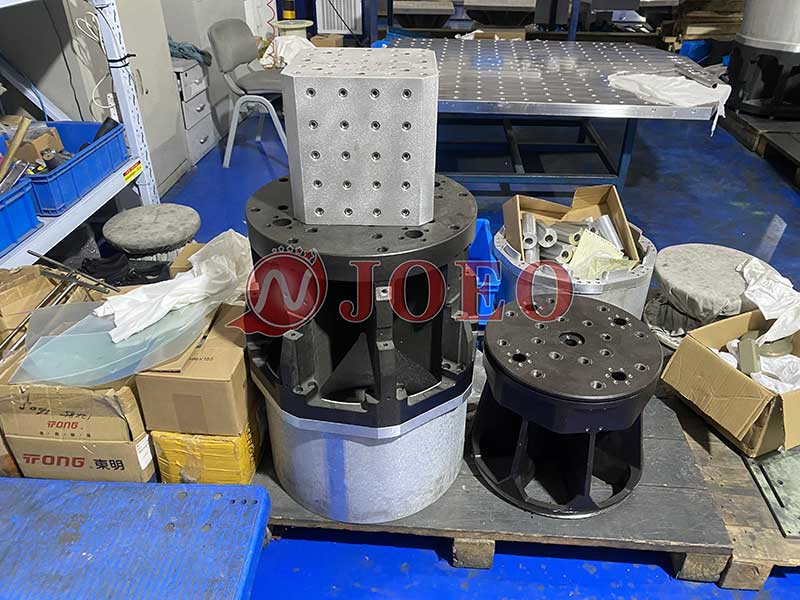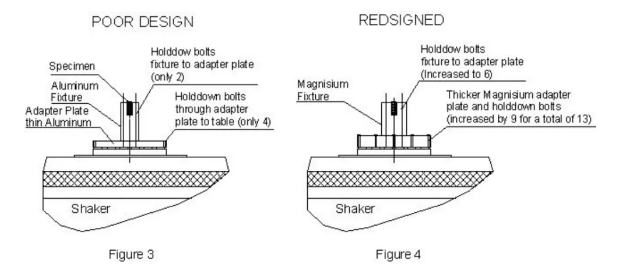A vibration fixture is a device used to hold the device under test during the vibration test process. It is the connection interface between the electric vibration device and the device under test. In some cases, a simple clamping or bolting method can meet the requirements, but in more complex cases, a customized more complex solution is required. In general, the choice and design of the fixture directly affects the quality and reliability of the test.

When designing fixtures, the actual size, shape, installation surface, and other characteristics of the tested item were not fully considered, resulting in inconsistencies between the fixture design and the shape or installation point of the tested item, misalignment, and potential damage during the testing process.
Weak or improper fastening may cause the test items to detach, affecting the integrity and safety of the testing.
The weight or size of the test item exceeds the bearing capacity of the fixture, which may cause damage to the structure of the fixture or the failure of the entire fixture system.
Let’s take a quick look at an example
In this vibration test, the sample is mounted inside a cubic aluminum fixture. The fixture is then secured to a 14-inch thick aluminum adapter plate via four anchor points. This adapter plate is mounted on a spring at four other fixed points and is subjected to a violent resonant vibration.
Aiming at the problems existing in the design of the above test fixture, two solutions are proposed:
Redesign the fixture and attach it directly to the shaking table with 4 or more bolts to strengthen the connection.
The adapter board was redesigned, made into a magnesium alloy material about 1 inch thick, and secured at 13 connection points on the shaker. Additional bolts can also be added to connect the fixture to the adapter plate.
These two solutions can effectively solve the problems existing in the previous fixture design and improve the reliability and safety of the test. Figure 3 and Figure 4 respectively show the test fixture design before and after the improvement.


In this test, the item under test was a small electronic component that was clamped onto a 5x5x12 inch rectangular aluminum plate. The aluminum plates are then mounted on a clamp that is secured to the shaking table by permanent bolts.
In the initial design, the fixture used a box structure made of 38 mm thick welded aluminum plates, as shown in Figure 1. However, in the vibration frequency band below 1000 Hz, the test project has a serious resonance amplification phenomenon, resulting in the measured acceleration is more than 10 times higher than the vibration table accelerometer reading, and it is impossible to carry out normal vibration test.
In response to the serious resonance problems of the initial design, the researchers redesigned the fixture with a solid magnesium cube structure with multiple holes in the surface to reduce weight. At the same time, more fixing bolts are used to firmly install the fixture on the shaking table.
This redesigned fixture, its resonant frequency increased to more than 2kHz, in the vibration test has not been found before the serious resonance problems, the test process can be carried out smoothly.
The JOEO vibration test fixture has the following characteristics:
JOEO provides customers with comprehensive services for customized shaker table testing. Our vibration expert team has over 20 years of rich industry experience and can participate in the entire project lifecycle, from preliminary conceptual design to final manufacturing and production, providing a one-stop turnkey solution for your shaker table testing needs. With outstanding technical capabilities and rich industry experience, we are able to customize exclusive vibration testing devices that meet the specific requirements of our customers, ensuring the provision of high-quality and reliable vibration testing services.
If you have any further questions or needs regarding our vibration test fixture design, please feel free to contact us through our fixture design consultation form. Our professional team will carefully understand your specific needs and make every effort to provide you with thoughtful and meticulous assistance and solutions.